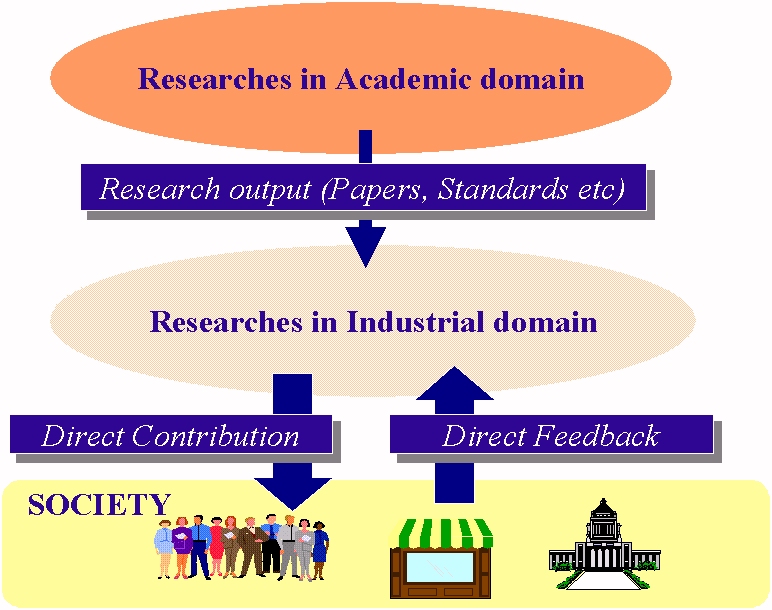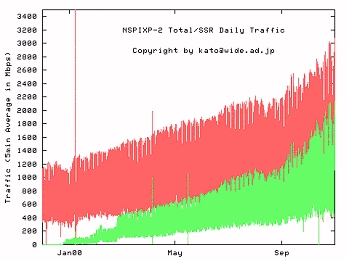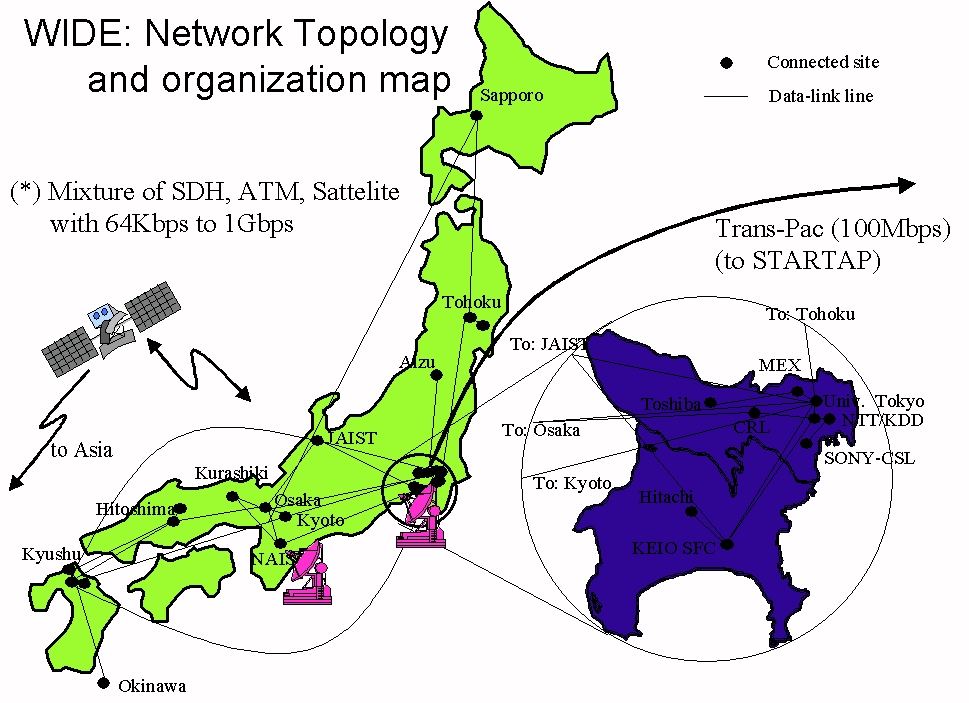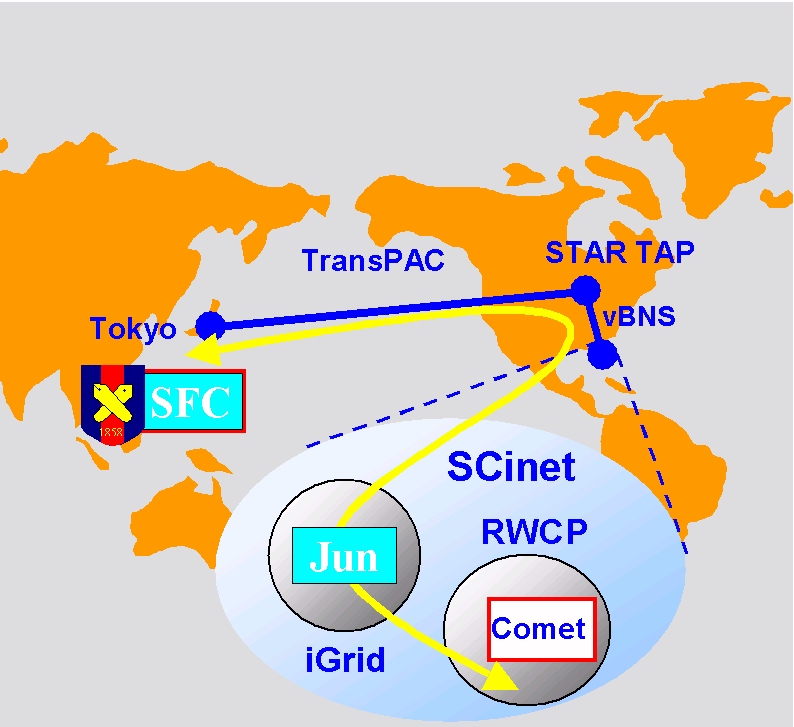Abstract
WIDE, Widely Integrated Distributed Environment, Project is a research consortium among academia, industry and government, regarding the Internet related technology. WIDE Project has more than four hundreds of active research members from more than 50 private corporations. WIDE Internet was founded to support Internet-related technology researches and developments and to enable the electronical communication among project members. As it evolved, it played a key role in the growth of the Internet, well before commercial ISPs became popular. WIDE now operates several test projects, such as gWIDE 6boneh to deploy IPv6 technology, gWISH AI3h for satellite internet platform, and gRT-boneh for QoS-aware network. WIDE envisions the future of the gMobile Computing Environmenth and next-generation gnative Internet generationh by constructing a gMulti-Gigabit Backboneh such as DWDM.
The WIDE Internet is ;
(1) Accommodating common traffic
(2) It is research network, is not commercial network
(3) Maintaining scale of network and volume of traffic
(4) Maintained and operated by ourselves
(5) Part of global Internet
The following words represents the structure and operation of the
WIDE project.
gOperations in our right hand, Researches in our left
handh
== begin {before WIDE project} ==
1981 N1 Started== end {before WIDE project} ==
1982 Network installed at Keio University Yagami campus
19841985 Rearch Group started (Predecessor of WIDE Project)
- JUNET started
- First connection between Tokyo Institute of Technology and Keio University (300bps)
- Tokyo Institute of Technology, Keio University and University of Tokyo are connected (1200 bps)
19861987 University of Tokyo and Tokyo Institute of Technology are connected
- Email with Japanese characters at JUNET
- Connected to CSNet(US), the first international connection for JUNET
== begin {WIDE project} ==
1988 WIDE project started (August)== continue (WIDE project) ==
19891990
- NSFnet and Univ.Tokyo connected by cooperation of NACSIS (9.6kbps)
- WIDE connected to US by dedicated line via Hawaii (64kbps)
- WNOC-Tokyo started (Iwanami-shoten, Publishers)
- WNOC-Kyoto started (ASTERM)
1991
- WNOC-Osaka started (Senri International Information Institute)
- WNOC-SFC started (Keio Shonan Fujisawa Campus)
- WNOC-Fukuoka started (System Soft Corporations)
1992
- WNOC-Sendai started (AIC)
- Increased bandwidth between SFC and Univ of Hawaii (192kbps)
- Network introduced to WIDE camp (64kbps)
1993
- INET92 at Kobe
- WNOC-Hiroshima started (Hiroshima University)
1994
- Connected to IIJ
- WNOC-Nara started (NAIST)
- WNOC-Sapporo started (Sapporo Electronic Center)
- Change international connection from Univ of Hwaii to NASA (FIX-W)
1995
- WNOC-Hamamatsu started (Shizuoka University)
- WNOC-Hachioji started (Tokyo University of Technology)
- VSAT introduced to WIDE camp (2Mbps Satellite link)
- WNOC-SFO started (Hayward, San Francisco)
- Increased international bandwidth (1.5Mbps)
- NSPIXP-1 started
1996
- WNOC-Gifu started (Softpia Japan Corp.)
- WNOC-Komatsu started (JAIST)
- Ryuichi Sakamoto internet concert
1997
- Internet 1996 WORLD EXPOSITION
- The first Internet disaster drill (IAA)
- IPv6 operation started between Tokyo and Osaka
- Collaborate to operate Atlanta Olympic Website
- NSPIXP-2 started
- Mobile computing joint test with Stanford University started
1998
- The second Internet disaster drill
- M Root DNS Server operation started
- SOI (School on the Internet) project started
- NSPIXP-3 started
1999
- The third Internet disaster drill
- Collaborate to operate Nagano Olympic/Paralympic game
- KAME project and TAHI project started
- WIDE project 10th Anniversary symposium
2000 INET2000 (Yokohama)
- The fourth Internet disaster drill
- WNOC-SFO closed
- WNOC-LA started (Los Angels)
- NSPIXP-6 operation started
- First IPv6 address assignment by APNIC
- C-band parabola antenna (7.6 meter at SFC and NAIST)
- Technical support to gLIFE Ryuichi Sakamoto Opera 1999h
- Hosted IETF IPng WG Interim meeting
- Distant learning using DV over IPv6 started at Keio University, Univ of Wisconsin and NAIST


Figure 2. Traditional R&D style
Figure 3. R&D style with WIDE project
There was a report by Dr.Chien (NSF, Harvard University), analyzing the research projects in Japan compared with the projects in USA. Figures 4 and 5 shows the results of the report.
As you can see, the WIDE project can be similar to Internet2 and Abeline
project in USA. These project accommodate a lot of advanced research institutions
from academic and industrial domains.
The WIDE project has a board, which is consisted by 20 voluntary members.
The WIDE board members have the responsibility to an every activity in
the WIDE project. We have monthly board meeting.
The research and development activities usually run based on the Working
Group. SIG, Special Interests Group, forms an Working Group including
researchers from different companies, in order to explore the research
and development of the particular technological challenge. Recently,
we may form a special project /task team to expedite the research and development
mission. KAME, TAHI and USAGI project would be typical examples,
regarding the IP version 6 technology. KAME is researching and developing
the IPv6 protocol stack for various BSD UNIX system.. TAHI is researching
and developing the IPv6 system evaluation framework and evaluation software
for IP version 6 systems. USAGI project is researching and developing
the IPv6 protocol stack for LINUX.
Below, the snap-shot of Working Groups in January of 2000 is shown.
1. InternetCAR
2. IP over IEEE1394
3. IRC
4. LAST (LAbel Switching Technology)
5. Lifeline
6. Diff-Serv
7. Lifelong
8. MAWI (traffic measurement and analysis)
9. MC (Multicast Backbone)
10. Mobile Security (mobsec)
11. MoCA (Security and Certification Authority)
12. Reliable Multicast
13. RT-Bone (Real-Time Backbone)
14. SOI (School on the Internet)
15. TWO (operation of the WIDE Internet)
16. v6 (IP version 6)
17. W4C (Web Cacheing)
19. WISH (UDLR via Satellite link)
20. WT (Internet Phone/FAX)
21. WWW Architecture
The importance of item (1) should be obvious. We need a common traffic,
otherwise we loose the real requirement for the actually operating network.
The user realize that the WIDE Internet is a research network, therefore
there would be some trouble in some cases. However, the WIDE Internet operators
(i.e., researchers) has maintained comfortable quality of service to the
ordinary users, in the past. Nowadays, the WIDE Internet accommodates
around 100 institutions, therefore the WIDE Internet should satisfy the
requirement (3). Of course, even the operation requires extra overhead
for the researchers, the researchers operates the WIDE Internet, while
working as the usual researchers or engineers. Finally, the WIDE
project member are trying to participate in the operation of global Internet.
For example, the WIDE project has the responsibility to the operation of
gMh root DNS server. Or, the WIDE project is leading the APNIC
and JPNIC regarding the IPv6 address assignment. Also, the WIDE project
is involving a lot of international network operations (e.g., APAN or 6REN).
The following picture illustrates the traffic exchanged at NSPIXP-2,
one of the major Internet exchange points in Japan. The statistics is obtained
by polling ifInOctets mib variable in every 15 min (every 30min before
April 21, 1997, and every 5min after Jan 14, 2000). The figures below are
not automatically updated, however, they are updated once a month.
Note that the statistics from Oct 17, 1997 to Nov 07, 1997 was not
collected due to snmp problem.
The total traffic reduction effective on the early December, 1997 is
due to the bootstrap of JPIX, a commercial based internet exchange in Tokyo.
Their traffic statistics is shown here.
However, even with JPIX, the traffic grows more than linear growth.
One of the reason is that we operate a News server at NSPIXP2. The server
receives about 18GB and sends about 260GB news articles in a day, those
numbers yeild to 1.6Mbps and 24Mbps in average respectively. So the server
is not considered a big traffic source to NSPIXP2.
According to the fact that the FDDI interfaces for some
major ISPs are getting congested, we've launched its extension program
using Gigabit Ethernet switch since December, 1999. Now we use a Cabletron's
SSR8600 connected to the Digital Gigaswitches with four FastEthernets huntgroup
link. While those switches are on the same subnet, ISPs on the Gigabit
Ethernet switch are suggested to close their peering on the switch except
for those non-profit ISPs or NICs to avoid congestion over the huntgroup
link.
The entire aggregated traffic (red) and the aggregated traffic closed
to the Gigabit Ethernet Switch (green) isillustrated as below: While
FDDI is a very nice technology offering dual-homeing, it has only 100Mbps
(or 100Mbps each in a FFDT case). We are asking ISPs to removing to the
gigabit ethernet switches (or an fastethernet port on them). As the result
the traffic exchanged within FDDI gigaswitches are slightly decreasing
as illustrated below:

Figure 9. Traffic at Gigabit Ethernet Switch (SSR)
Figure 10. Traffic at FDDI switch (Gigaswitch)
If we plot the same data for last 3 months with x-axis folded as 24hour,
we get the following. You can notify that the peak of traffic happens in
after-lunch and mid-night. Latter is thanks to the NTT's "tele-hodai" program,
in which the contracted subscribers are not charged for dialup calls to
specified numbers (a user can specify up to 2 numbers) between 23:00 and
8:00 localtime. Unlike in U.S.A., flat-rate local call service was not
available in Japan. NTT-East and NTT-West, which are the local carriers,
have started to offer "Flet's ISDN" service for ISDN customers since mid
May. 2000. It is a flat-rate program (for the cost of local loop) which
costs 4,500 yen per 1 B channel (64kbps). Other non-intermittent connectivities
including CableTV based service as well as xDSL are getting popular in
2000. Are you interested in the weekly traffic pattern? It is illustrated
as follows. When the Internet was academic-use only, there was very small
traffic in a weekend day compared with one in a working day. No such characteristics
has remained. The traffic in a weekend day almost equals to one in a working
day.
(1) Technology for people
A key objective of the WIDE project is to make work, as much as possible, the vast potential for computer and communication technology to the benefit of people and society. The WIDE project focuses on creating new computer communication structures. To achieve these goal, there are many technologies that must be integrated. The research projects covers computer networks, security technologies, operating systems, multimedia information processing, decentralized processing, computer education, system monitoring, et al. To create the ideal next generation computer communication environment, the WIDE aims at facilitating open and productive communication and discussions among wide range of researchers.(2) Technology for the future of the Internet
It has been ten years since the WIDE project originated. During this period, Internet environment evolved so dramatically. We have been making contribution to construct the Internet both domestically and globally, as one of the leading research group. We also contribute to identify and support promising cooperative research and development opportunities for our member organizations. Therefore, the technology collected and shared by the various WIDE project research activities will continue to play a significant role in the continuing development and deployment of the Internet technologies.(3) Cooperation with Social Projects
The WIDE project has been expanding the landscape of the Internet worlds since its dawn. Participated projects show a diver range including ? emergency services by IAA (Survivor Information System, i.e., gI Am Aliveh), Internet education in the gOne Hundred Schoolsh project, disabled accessibility, Paralympics, live internet coverage of Atlanta and Nagano Olympics, concerts, Kabuki plays and other live events. We will continue to challenge the future of the Internet, to make it as useful as humanly possible.
The researches and developments in the WIDE project are carried
on with Working Group, that is a king of SIG (Special Interest Group).
The members of Working Group come from various institutions to collaborate
with. Below, the snap-shot of Working Groups in January of 2000 is
shown.
1. InternetCAR
2. IP over IEEE1394
3. IRC
4. LAST (LAbel Switching Technology)
5. Lifeline
6. Diff-Serv
7. Lifelong
8. MAWI (traffic measurement and analysis)
9. MC (Multicast Backbone)
10. Mobile Security (mobsec)
11. MoCA (Security and Certification Authority)
12. Reliable Multicast
13. RT-Bone (Real-Time Backbone)
14. SOI (School on the Internet)
15. TWO (operation of the WIDE Internet)
16. v6 (IP version 6)
17. W4C (Web Cacheing)
19. WISH (UDLR via Satellite link)
20. WT (Internet Phone/FAX)
21. WWW Architecture
[1] IPv6 Core Platform Research and Development
We have several special project, that would be rather task force
team to develop the IPv6 core technologies. The followings are some of
these activities.
(1) KAME Project (http://www.kame.net)
KAME stands KarigoME office, where the project members are working together. KAME project has started from 1998. The eight engineers from various companies, which are IIJ (Internet Initiative Japan), Hitachi, NEC, Fujitsu, Toshiba, Yokogawa, YDC, Sony, are working together. Before the KAME project established, the WIDE project has been working on the IPv6 technology at v6 Working Group, that is still active along with KAME project. KAME project has more intensive and clear mission, than the v6 Working Group has. It is the research and development of IPv6 reference software for the IPv6 community. Before KAME, each institution had implemented their own protocol stack, even in the WIDE project. One of primary purpose of KAME project is unifying the various implementations in WIDE project, as well as in the world. After the unification within the WIDE project, we have worked with INRIA group in France and NRL group in USA to unify the protocol stack. Finally, most of the protocol stack are come from KAME team, and the KAME team maintains the unified protocol stack. The KAME project is still running, while improving the quality of software and introducing new functions, such as multi-homing or router renumbering. Apparently, these are the other purpose of KAME project.(2) TAHI Project (http://www.tahi.org)
As a result, many UNIX software packages use the KAME protocol stack to let IPv6 work. These are FreeBSD, BSD-OS, OpenBSD, NetBSD and MacOS-X (Server). Also, some router vendors, such as Hitachi or Yamaha, uses the KAME protocol stack in their commercial router.
The followings are the abstract of functional snap-shot for KAME IPv6 protocol stack.- IPv6 basic functions, e.g., NDP, autoconfiguration
- IPv6 basic and advanced API
- IPSec (IP Security function)
- Basic applications, e.g., sendmail, telnet, web
- Routing protocols, i.e., RIPng, OSPFv3, BGP4+, PIM-SM/DM (multicast)
- Integration with ALTQ (packet scheduler) for quality of service
- Integration with Diff-Serve, RSVP, COPS and Bandwidth Broker
- Multi-Homing function
- DNS server (BIND) and client (resolver) software for IPv6
- Integration with MPLS technology
TAHI project is run by Yokogawa Corporation, the University of Tokyo and with WIDE project. The TAHI project, started from 1998, is also run by the mission oriented task force team. The project goal is to research and develop the evaluation specification and evaluation tools for IPv6 protocol stack. The output of the project is available as the open source. The test specification and tools includes the IPSec and routing functions, as well as basic IPv6 specification. TAHI project is closely collaborating with KAME project and USAGI project, in order to improve both of software quality.(3) USAGI Project (http://www.linux-ipv6.org)
TAHI project has hosted two international interoperability test workshop, in 1999 and 2000. The first workshop was conjunction with IETF IPng-WG interim meeting, participating from 17 institutions. The second workshop was conjunction with INET2000, also participating from 17 institutions. The participating institutions include cisco systems, MicroSoft, 3Com, Ericsson or NOKIA. This means that major vendors for host and routers have participated in the workshop using the TAHI output.
TAHI project will challenge to investigate into the area of Internet Appliances, that is non-computer equipment with Internet connectivity. These equipments has some hardware and software limitation, while satisfy the appropriate privacy and security function.
USAGI stands for UniverSAl playGround for IPv6 ), and focusing on the IPv6 protocol stack for LINUX system. The USAGI project has started from August in 2000, in order to improve the quality of IPv6 functions in LUNUX. As same as the KAME project, the engineers from various institutions, such as MPT-CRL, Hitachi, Yokogawa, Toshiba, Keio University, Tohoku University, work together. The first software package by USAGI project has released Nov.1st in 2000. The USAGI project will work to develop the LINUX system as the same level of IPv6 quality as BSD system has with the KAME protocol stack.(4) LIN6 Project
LIN6 stands for gLocation Independent Networking with IPv6h. The goal of this project is focusing on the global mobile environment with authentication of the end node. The issues, that LIN6 architecture try to solve, are;(5) Small Group Multicast (MDO6)- Multi-homingThe primary implementation for the prototype system has completed, to propose the architecture and specification to the IETF.
- Scalable end node authentication in global space
- Separation of routing information and end node identification
There are many small group multicast in the Internet, as well as the multicast including large number of receivers. In order to provide the small group multicast easily, a new architecture and protocol, that uses the IPv6 option, is proposed to the IETF.(6) IPv4 internetworking
The WIDE project member implements two approaches to internetworking IPv4 system and applications with IPv6 networks. One is BIS (Bump-In-the-Stack), and the other is IPv6/IPv4 translator. BIS, developed by Hitachi Co.Ltd, is the software for MicroSoft Windows 95 and Windows98 system, in order to run the existing applications over the IPv6 network environment. With the BIS software, you do not need to re-install the existing software for IPv4 MS Windows. BIS is implemented between the kernel and the driver. BIS has the IPv6/IPv4 translator module within the end node. The other one is IPv6/IPv4 translator, that sits between IPv4 network and IPv6 network. KAME project implemented the NAT-based translator and the application gateway based translator.[2] IPv6 Applications
(1) Digital Video Transmission System (DVTS)
(www.sfc.wide.ad.jp/DVTS/, www.csl.sony.co.jp/person/kjc/software.html)
DVTS is IP-based, high-quality, real-time audio/visual (AV) communications software that uses Digital Video (DV) camcorders and VCR consumer products with IEEE 1394 (Firewire) interfaces. DVTS works with both IPv4 and IPv6 on a FreeBSD system, and is integrated with the ALTQ module to enable fine packet transmission scheduling and DiffServ.
RTP (Real-time Transport Protocol) provides interoperability among systems, and achieves dynamic flow control among hosts. For the highest quality communication, the system consumes over 35 Mbps of network bandwidth. Using RTP, DVTS achieves dynamic flow control and optimizes the DV transmission for the available bandwidth., e.g., DV transmission over 10base-T Ethernet.
DVTS software is already integrated with the following functions; (a) Internet-friendly flow control, (b) Remote control with SSH, (c) Full encrypted (ESP) DV transmission with IPSec, and (d) DV multicast with PIM-SM/DM.
DVTS software is used many events and institutions in global level. Figure 15 and 16 show the abstraction of DVTS architecture.

Figure 17 shows the network configuration of the experiment for DV multicast
over the WIDE backbone. The IP protocol version is six (i.e., IPv6).
Also, figure 18 shows the equipments used in the experiment. The
WIDE project workshop is multicast to the nation-wide WIDE NOCs, using
the IPv6 with PIM-SM (PIM Sparse Mode).
(2) School on the Internet (http://www.sfc.wide.ad.jp/soi/)
The goal of gWIDE University, School on the Interneth, is to establish a new form of Internet-based educational institute and determine the best system for doing this. Many leading Internet experts and professionals are participating in this project with regard to creating the curriculum and specific learning objectives. By November 1999, the archives equivalent of 320 hours of class work were already uploaded publicly to the internet and were utilized by 300 registered students. The gWIDE University, School on the Interneth offers real time lectures to other universities and institutions internationally over high speed Internet connections. gWIDE Universityh envisions new forms of Internet-based learning institutions where people can lean ganywhere, anytimeh.
In 1999 and 2000, the real time distance learning among Wisconsin University, Keio University and NAIST has been carried out for a whole of one semester. Figures 19 shows the abstract of this class.

Figure 19. Network configuration of School on the Internet experimentThe SOI system after the Wisconsin University remote class over the Internet accommodates larger participating institutions and links. The features of the on-going SOI system are as followed.
- Wide variety of links; High speed wired link (OC-3, OC-12), high speed (45Mbps) satellite link, ISDN link
- Participating institutions ; nation-wide universities, residential
- Expanding to further international institutions, such as Stanford University and NTT-MCL in California
[3] IPv6 Operations
As described above, the WIDE project has researched and developed
the IPv6 reference software, that include the software tools (e.g., translator
or BIS software) to proceed the IPv6 migration from the existing IPv4 environment.
Using these software and IPv6-enabled commercial products, some ISPes and
research networks are operating the IPv6 technology. The WIDE project
leads the IPv6 network operation with WIDE Internet and NSPIXP. The
WIDE Internet is achieving the migration to the IPv6 network from IPv4
traditional network, while having the co-existing and co-operation of IPv4
and IPv6 networks. It should include the IPv6 address allocation and registry,
as well as the IPv6 routing registry.
The IPv6 readiness in the NSPIXP2 has a significant influence to the
industry, since many commercial ISPes (almost all major ISPes) use the
NSPIXP2 and NSPIXP3 as the primary IX point in Japan. Also, the WIDE
project hosts the NSPIXP6, that is for rather challenging IX targeting
the IPv6 technology.
The WIDE project is going to initiate the IPv6 wide area testbed, including
many commercial ISPes, contents providers and internet appliances venders,
soon. The primary purpose of this testbed is proofing that the IPv6
technology and network has been already production quality to be ready
for commercial operation. Also, the testbed, that includes the residential
as well as campus network and enterprise network, tries to explore the
possibility of ubiquitous computing environment with IPv6 technology.
The WIDE project operates one of 13 global root DNS server, which is
called as M-root server. The WIDE project has the leadership for the IPv6
DNS deployment in the root DNS servers. In order to deploy the IPv6 network,
we have to deploy the DNS system, that is IPv6 ready. The activities
by KAME and USAGI project will deploy the IPv6 capability in the end host.
Therefore, the deployment of DNS system with IPv6 is important role for
the global IPv6 network operation.
The address allocation by the regional NIC (e.g., APNIC or RIPE) is
also the important deployment for IPv6. The WIDE project is closely
working with APNIC and JPNIC, regarding the IPv6 address allocation.
Finally, some WIDE project members are working with ICANN, that is
in charge of IP address allocation and DNS deployment. This means
that the WIDE project is deeply involving into the global IPv6 system deployment
activity.
1. InternetCAR (http://www.sfc.wide.ad.jp/InternetCar)
Research and development of system which support automobiles to utilize information on the Internet. Studies in basic technologies from installation and operating system to practical application.2. IP over IEEE1394
Figure 21 and 22 show the abstract of the Internet car system.
The position of car make extremely precise using the differential GSP technology. When we have a referenced base station, that can provide the error correcting infomration from the satellite, we can have a single digit cm (centi-meter) precision. Figure 23 shows the experimental result with the prototype InternetCar. Also, figure 24 shows the plan, that the WIDE project will be going to build to provide the differential GPS service around the WIDE project key NOCs.
The architecture model and protocol for IP service over IEEE1394 is discussed and evaluated. Now, we have the two implementation around IEEE1394. One is IP over IEEE1394, the other is IEEE1394 over IP. The later one is related with DVTS application software described above, and is used in the School on the Internet system to distribute the DV (Digital Video) data with IEEE1394 interface from the digital camera.3. IRC (Internet Relay Chat)
IRC working group is working on the Internet Relay Chat system.4. LAST (LAbel Switching Technology)
The WIDE project member has proposed the CSR architecture, that is the root of IP Switch by Ipsilon and of Label Switch Technology, to the IETF and ATM Forum in 1994. The MPLS (MultiProtocol Label Switching) working group has been established at the IETF in 1997. The WIDE project has started the operation of CSR prototype system around 1996 using the WIDE Internet, and has provided a lot of technical contributions to the IETF. Also, the LAST working group has achieved the integration of IPv6, Diff-Serv, PIM-SM/DM. Figure 25 gives the typical NOC configuration for the testbed operation.5. Lifeline
Life line working group researches and develops the internet system, that is effectively useful in the case of disaster, such as earthquake. Actually, Japan has experienced serious earthquake and several eruptions, and realized the importance of lifeline capability of Internet system. Actually, at Kobe earthquake in 1995, people did realize the importance and effectiveness of the Internet system, in order to the information who are alive. So, the lifeline working group has developed the IAA system, that stands for gI Am Aliveh. IAA system provide the information, who are alive, to the world using the Internet technology. The lifeline working group has started the disaster drill from 1996. We have disaster drill twice in a year, that is working with many institutions including the local governments. Also, the developed system will be introduced to the case of disaster, such as eruptions in Japan.6. Diff-Serv
Diff-Serv working group has established in 2000, in order to research/develop/deploy the differentiated service technologies and network. The working group will establish the experimental network, that is Diff-serv aware.7. Lifelong
The internet system and computer system should support the peoplefs activities during his whole life. For the existing computer system, we have to change many information (e.g., email addresses or account), during our life. Lifelong working group is researching the computer system, that is effectively useful during our whole life.8. MAWI (traffic measurement and analysis)
The Internet system runs based on the cooperation of networks and end-nodes. Also, it is very hard to control and manage the network effectively. In order to control and manage the Internet system well, it is realized that the traffic measurement and analysis is an important issue and research topics. For example, in the USA, there are CAIDA project, that researches and develops the traffic measurement tools for the Internet. The goal of the MAWI working group would be similar to the CAIDA. The MAWI working group works with the WIDE Internet.9. MC (Multicast Backbone)
The WIDE Internet is a part of global M-Bone (Multicast Backbone). The WIDE Internet includes the satellite link with UDRL, as well as usual wired links.10. Mobile Security (mobsec)
The mobile system needs the security function, especially for mobile user belonging to certain private company. The mobile user, accessing the private network from the Internet space, has to work with firewall router, that is at the boarder between the Internet and private network segment. Mobsec working group researches and develops the security functions and protocols for mobile host.11. MoCA (Security and Certification Authority)
MoCA working group researches and develops the security related technologies, such as authentication. Also, this working group establishes and deploys the security related infrastructure, such as Certificate Authority. The WIDE project operates its own certification authority, called MoCA.12. Reliable Multicast
The multicast service is going to step forward to provide the error free packet delivery to every receivers. This is reliable multicast, where the conventional multicast provides just a best effort packet delivery to the receivers. Working group is clarifying the system and technological requirements and approaches to achieve the reliable multicast service. As discussed at IRTF and IETF, it will be a building block based architecture. Some engineers have worked to develop the FEC (Forward Error Correction) function, that should be recognized as one of the key technological element in the reliable multicast framework..13. RT-Bone (Real Time Backbone)
RT-Bone working group researches, develops and deploy the network, that supporting the realtime data transport over the Internet. The working group activity is going to be merged with the Diff-Serv working group.14. SOI (School on the Internet)
As described in the section 4.2, the WIDE project has been developing and deploying the SOI infrastructure and operation, that is open to everyone connected to the Internet. The SOI activity is global, so that the lectures are multicast from oversea and to oversea.15. TWO (operation of the WIDE Internet)
Two working group is in charge of the operation and management of the WIDE Internet. Since the WIDE Internet serves not only to the WIDE members but also to the other ordinary people who are connected to the WIDE Internet, the operational quality has to be a production quality. The uniqueness of the WIDE Internet operation by the two working group is the introduce of the new technologies developed by the researchers, while keeping the production quality operation.16. v6 (IP version 6)
v6 working group would be a kind of mother working group for the several task force oriented projects, such as KAME ands USAGI projects. The v6 working group works for the wide range of researches, developments and deployment of the IP version 6 technologies.17. W4C (Web Cacheing)
The growth of the traffic by the WWW system became the dominant, regarding the traffic volume in the Internet. In order to have efficient and comfortable Web access, a cache technologies should be established. W4C working group researches, develops and deploy the Web cache system, in order to improve the Web access performance, such as content delivery network technologies.19. WISH (UDLR via Satellite link)
WISH working group works on the research and development of the Internet communication platform using the satellite system. This working group is a technological core for the AI3 project. Also, one of the significant research outputs is the UDLR (UniDirectional Link Routing) system architecture and protocol. The UDLR has been proposed to the IETF to established the working group. The working group has been managed with INRIA (France) to have the global standard for UDLR system. Also, this working group is working with INRIA, in order to make sure the interoperability between the two UDLR system by the WIDE and INRIA.20. WT (Internet Phone/FAX)
The WISH working group has deployed the network shown in figure 26 and figure 27.
Conventional services using the POTS infrastructure should be important to integrate all services over the Internet, as well as internetworking with the POTS network. Voice over IP and Facsimili service over the Internet are the target of this working group. The voice over IP system has been developed and the experimental system across the Pacific ocean had been deployed.
The facsimili service over the Internet is called as the gInternetFAXh. This working group has researched and developed the architecture and protocols for the InternetFAX system. The output of the activities are proposed to the IETF and formed the working group, named as gifaxh working group. The member of this working group contribute to the IETF, and publish the standard track RFC. Also, the ifax working group of IETF has worked with the ITU-T, that standardizes the technological standard of telecommunication system, and the ITU-T has adopted the specification defined by the IETF. Figure 28 shows the system diagram of ifax system.
The figure 29 shows the network topology of the WIDE Internet backbone.

Figure 29. The network topology of the WIDE Internet backbone
[Domestic Wide NOC]
[Internatoinal Wide NOC]
[Cooperating domestic network]



Figure 30 Network Configurationat SC98

Figure 31. Remote Lecture from Orland (USA) to Keio SFC(Japan)

Total 90 organizations
As of January 2000 alphabetical order
Total 35 organizations
As of January 2000 alphabetical order